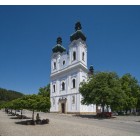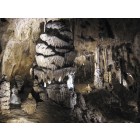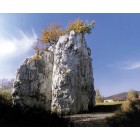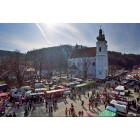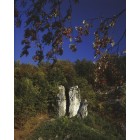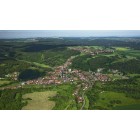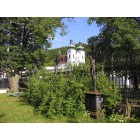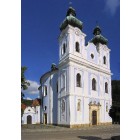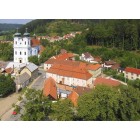The market town of Sloup lies in the north of the Moravian Karst protected landscape area and is an important place of pilgrimage. Pilgrimages are held here on a regular basis (the largest on the Friday a week before Easter and on the third Sunday in September on the Day of Our Lady of Sorrows).
The first reliable documentation of the existence of Sloup is to be found in the Moravian Provincial Records of 1373. Skeletal finds in the Kůlna (Shed) Cave testify, however, to settlement in the age of the Neanderthals. Sloup won the prestigious title “Village of the Year” in the year 2000.
The most impressive natural feature in the town and its greatest tourist attraction are the local Sloup-Šošůvka Caves. The entrance area of the caves is dominated by the solitary “Hřebenáč” boulder, after whose column shape the town is named (sloup = column).
The cultural monuments in the town include the Baroque Church of Our Lady of Sorrows built in the years 1751–1754. Its founder, Countess Caroline of Roggendorf, is buried in the church’s crypt. The local presbytery, where the countess died in 1759, is another important cultural monument. A number of members of the Salm family, to which the Rájec estate and, with it, Sloup itself passed, are buried in a detached part of Sloup cemetery, another of the town’s cultural landmarks. Its registered monuments also include the Kůlna (Shed) Cave, in which skeletal remains of Neanderthal man have been found and which is a site archeologically unique in Europe.
In addition to these registered monuments, there are also a number of other small pieces of ecclesiastical architecture in Sloup, such as the Chapel of Saint Peregrine. The town also has three memorial trees – the linden tree by Hřebenáč (around 250-years-old) and the two Salm lindens in the Salm cemetery (around 150-years-old).
The first reliable documentation of the existence of Sloup is to be found in the Moravian Provincial Records of 1373. Skeletal finds in the Kůlna (Shed) Cave testify, however, to settlement in the age of the Neanderthals. Sloup won the prestigious title “Village of the Year” in the year 2000.
The most impressive natural feature in the town and its greatest tourist attraction are the local Sloup-Šošůvka Caves. The entrance area of the caves is dominated by the solitary “Hřebenáč” boulder, after whose column shape the town is named (sloup = column).
The cultural monuments in the town include the Baroque Church of Our Lady of Sorrows built in the years 1751–1754. Its founder, Countess Caroline of Roggendorf, is buried in the church’s crypt. The local presbytery, where the countess died in 1759, is another important cultural monument. A number of members of the Salm family, to which the Rájec estate and, with it, Sloup itself passed, are buried in a detached part of Sloup cemetery, another of the town’s cultural landmarks. Its registered monuments also include the Kůlna (Shed) Cave, in which skeletal remains of Neanderthal man have been found and which is a site archeologically unique in Europe.
In addition to these registered monuments, there are also a number of other small pieces of ecclesiastical architecture in Sloup, such as the Chapel of Saint Peregrine. The town also has three memorial trees – the linden tree by Hřebenáč (around 250-years-old) and the two Salm lindens in the Salm cemetery (around 150-years-old).


